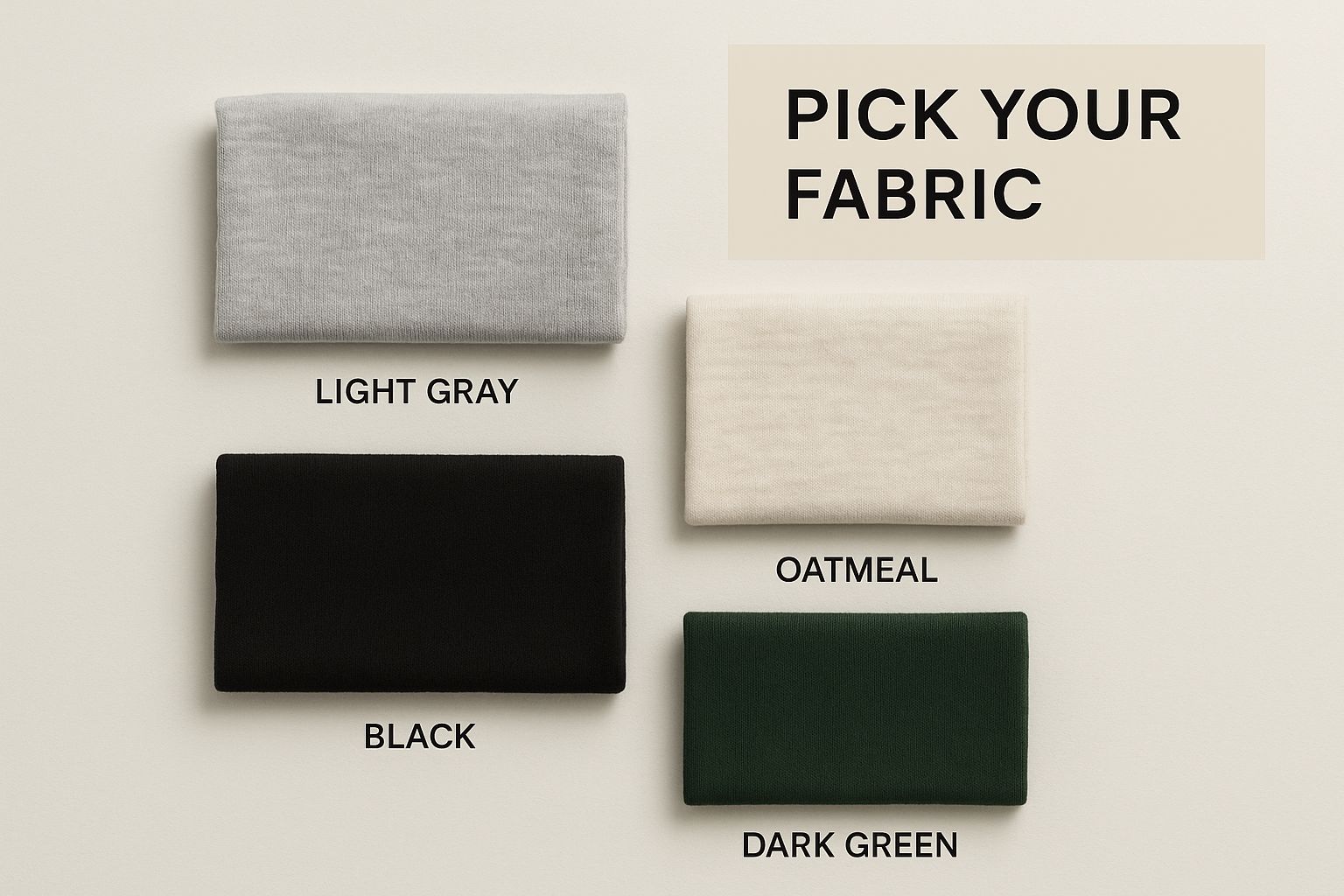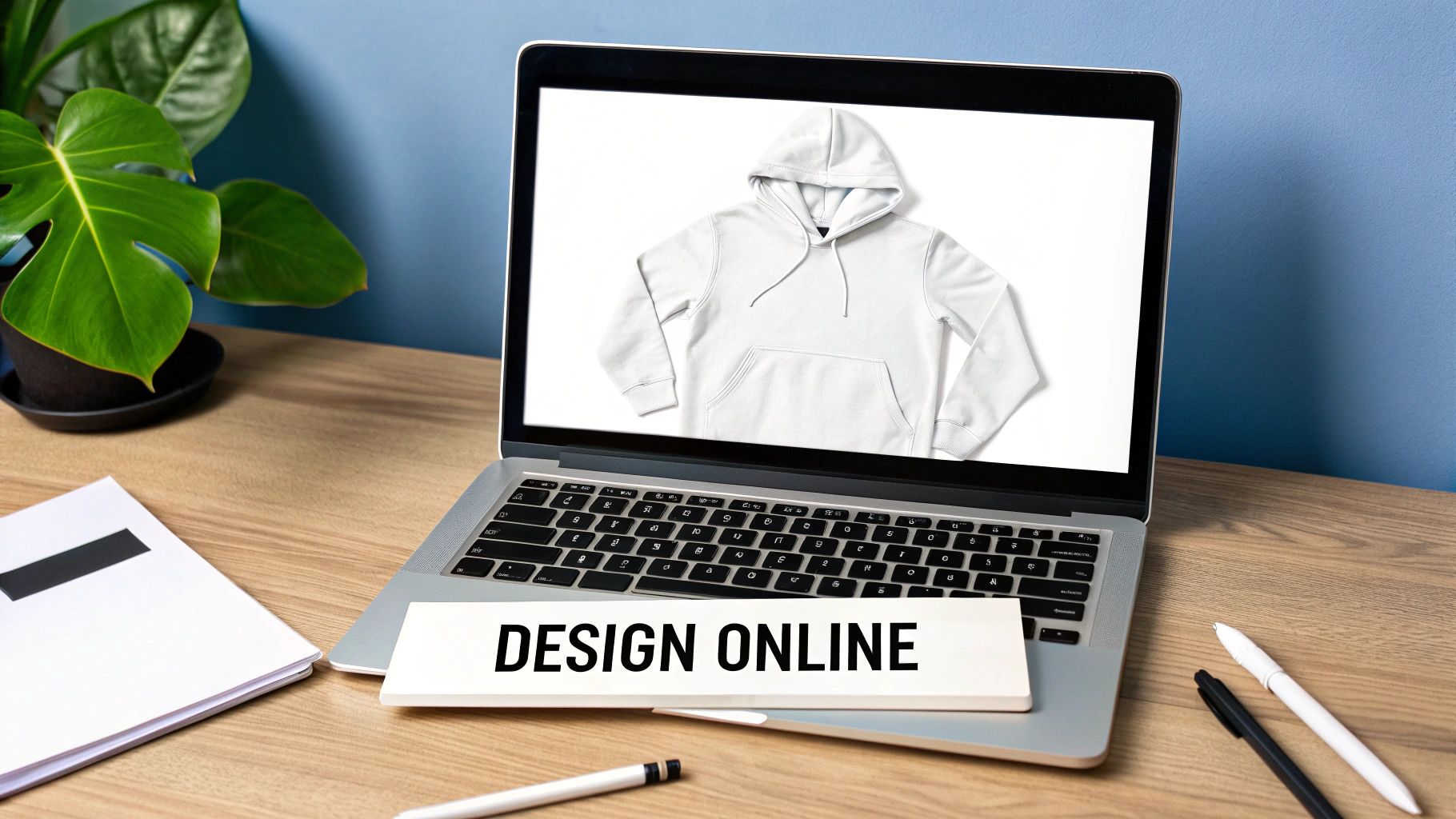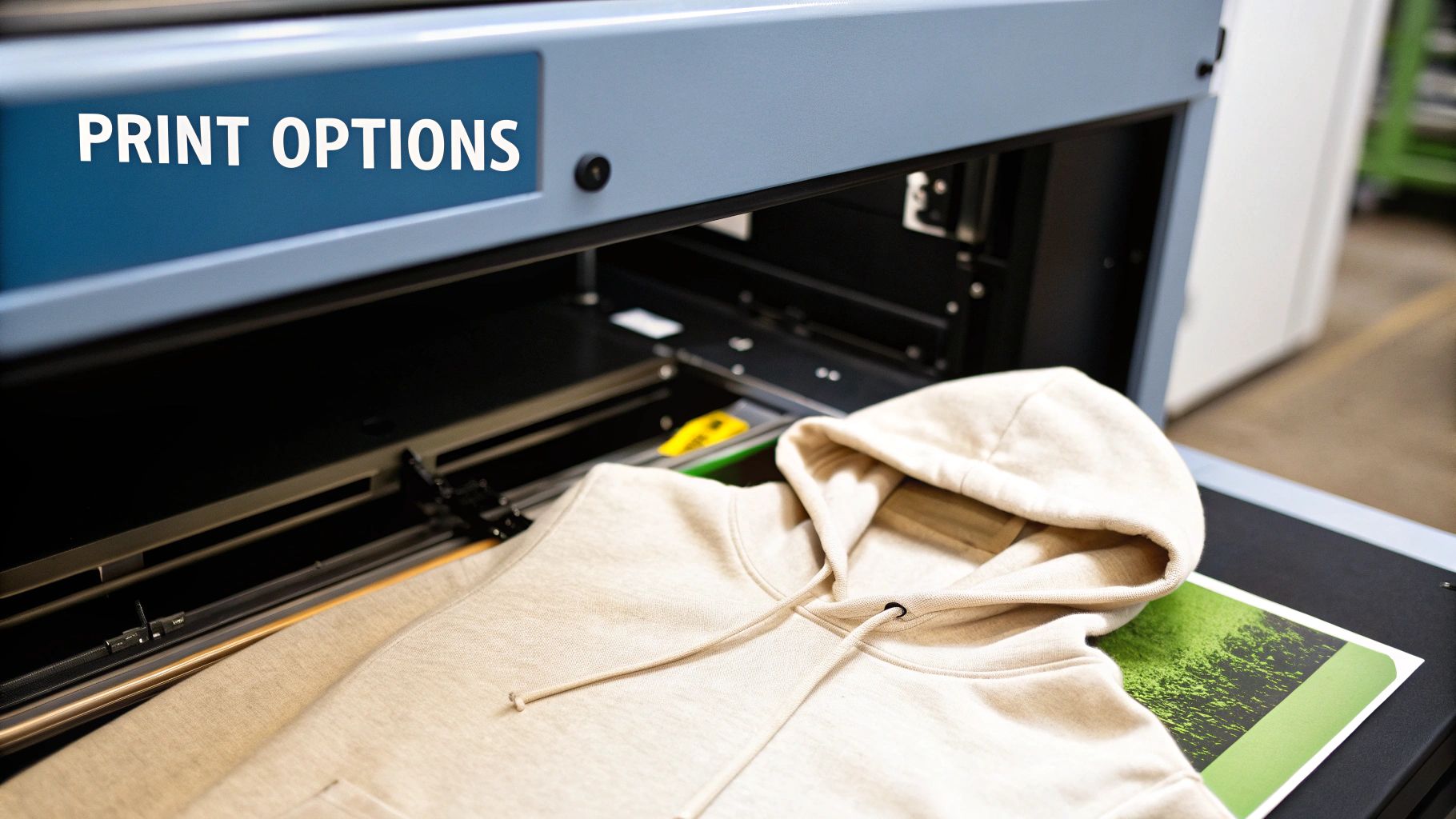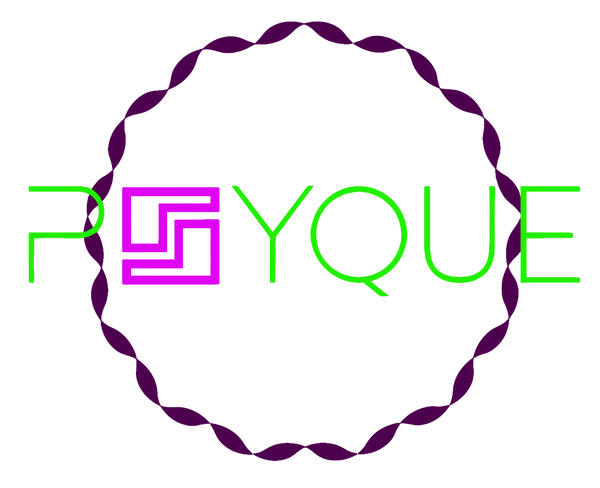
Design Your Own Hoodie UK | Create Unique Custom Hoodies
Share
So, you’ve got an idea for a custom hoodie that needs to exist. Good. You're in the right place. To design your own hoodie in the UK, you need more than just a cool graphic; you need a solid plan, a quality garment, and a printing partner who gets it.
Let's break down how to get it done right.
Your Guide to Creating the Perfect Custom Hoodie
Making a custom hoodie isn't just about slapping a logo onto a blank sweatshirt. It's about creating something that feels like yours—whether it’s for your brand, your team, or just for you. This guide is your no-nonsense roadmap. We’re skipping the generic advice and getting straight to what actually works.
We’ll walk you through turning that spark of an idea into a real, high-quality hoodie you’ll actually want to wear. The principles are the same whether you're making one for yourself or a hundred for your new merch line. The difference between a killer hoodie and a cheap-looking one is always in the details—from the fabric you choose to how you prep your artwork.
As you get started, remember there's a whole world of personalised gear out there, including custom hoodies designed to fit a specific vibe or message.
What This Guide Actually Covers
This is a full walkthrough designed to take the guesswork out of the process. We're hitting the four key areas that will make or break your project:
- Choosing Your Foundation: We’ll get into selecting the perfect blank hoodie. Think fabric, weight, and style. It matters more than you think.
- Artwork That Works: I'll share some pro tips for getting your design files print-ready so they look sharp and vibrant, not blurry and cheap.
- Printing Methods, Explained: You've probably heard of DTF, screen printing, and embroidery. We'll cut through the jargon and explain what's best for what.
- Placing the Order: A step-by-step look at how to order from a UK supplier, from seeing the first mock-up to getting the final package.
Get these four things right, and you'll sidestep the common mistakes that ruin good ideas. Honestly, the difference between an average custom hoodie and a great one comes down to a bit of planning before you even think about hitting 'print'.
This guide will give you the knowledge to make smart decisions, so the final product doesn't just look good, but feels right. Let’s get into it.
Choosing the Right Foundation for Your Design
Before you even think about graphics and colours, let's talk about the hoodie itself. The fabric, weight, and style are the canvas for your entire project, and getting this part right is crucial when you design your own hoodie in the UK. A killer design on a rubbish garment is a wasted opportunity.
The fabric is everything. A 100% cotton hoodie has that classic, soft, breathable feel everyone loves. But, polyester blends often make DTF prints pop more vibrantly and hold their shape better after a wash. A poly-cotton mix usually gives you the best of both worlds—the comfort of cotton with the durability and colour-holding power of polyester.
Fabric, Style, and Fit
Think about who's wearing this. Is it for a streetwear brand that needs a premium, chunky feel? Go for a heavyweight garment. It feels substantial and is perfect for winter. On the other hand, a lighter blend is way better for athletic wear or for layering up when the weather can't make its mind up. The style—classic pullover versus a zip-up—also completely changes the vibe and how it'll be used.
The fabric swatches below give you a better idea of how different materials look and feel up close.

This just shows how much the fabric choice impacts the final printed hoodie. It's not a minor detail.
Getting the size right is just as important. A bad fit can ruin the best design on earth, so you need to be confident in your measurements. If you're unsure, our unisex hoodie size chart has all the details you need to get it spot on.
Choosing the right hoodie isn't just a detail; it's the canvas. Your decision here affects everything from print quality to how often someone will actually want to wear your creation.
And people do want to wear them. The demand for high-quality custom hoodies is huge, with the UK market making up 12.33% of the entire European hoodie scene. That tells you customers here are actively looking for unique, well-made gear that stands out.
Preparing Your Artwork for a Flawless Print

Alright, you've picked out the perfect hoodie. Now comes the part where your vision really comes to life—the artwork. This is the single most important step in avoiding a print that looks blurry, pixelated, or just plain disappointing. A killer idea can be completely let down by a low-quality file.
First up, let's talk resolution. We've all seen those blurry graphics that look like they were pulled from a 20-year-old website. To avoid that, your file needs to be 300 DPI (Dots Per Inch). That’s the gold standard for printing. It ensures every line and detail in your design is sharp and crisp, not fuzzy. Grabbing an image off social media is a common mistake and almost guarantees a poor outcome.
File Types That Actually Work
When you’re ready to upload your design, the file format you choose is make-or-break. There are two main types of image files, and knowing the difference will save you a world of headaches.
-
Raster Images (PNG, JPEG): These are built from pixels. For DTF printing, a PNG with a transparent background is your best friend. Why? Because it means we only print your design—not a clunky white or black box around it. Your artwork will look like it’s part of the fabric, not just stuck on top.
-
Vector Images (AI, EPS, SVG): These are the kings of scalability. Instead of pixels, vectors use mathematical formulas. This means you can blow up your design from a tiny chest logo to a massive back piece, and it will never lose quality. If your artwork is a logo, text, or a clean graphic, a vector file is always the superior choice.
Key Takeaway: If you remember one thing, make it this: Export your final artwork as a 300 DPI PNG with a transparent background. This is the secret to getting a professional, clean DTF print that looks intentional and high-quality.
Getting Your Design Print-Ready
Before you hit 'save', take a second to think about colour. A bright yellow design might pop on a black hoodie, but it could completely wash out on a light grey one. A quick pro tip is to drop your design onto a colour swatch of your chosen hoodie in whatever software you're using. It’s a simple visual check that can prevent a lot of regret later.
Don’t have a degree in graphic design? No problem. If your image needs a bit of a touch-up, you can utilize AI photo editing tools to help sharpen edges or even increase the resolution.
These steps might sound a bit technical, but they're the foundation of a custom hoodie you’ll actually want to wear. If you want to dive deeper into the nuts and bolts of printing, our guide on personalised t-shirt printing has some extra tips that apply here, too.
Selecting the Best Printing Method in the UK

The printing technique you pick is what turns your digital file into a real, wearable piece of art. It’s the final step, and it dictates the final look, feel, and lifespan of your custom hoodie. Getting this right is absolutely crucial when you decide to design your own hoodie here in the UK.
There are a few classic methods kicking about. Screen printing, for example, is the old guard—solid, reliable, and amazing for big batches. It works by pushing ink through a stencil, making it super cost-effective for simple designs with just a few colours. Think bold text or a single-colour logo for a whole team. Then you’ve got embroidery, which stitches the design right into the fabric for a premium, textured finish that’s perfect for small crests and logos.
The Rise of Direct-to-Film Printing
But recently, a newer technology called Direct-to-Film (DTF) printing has completely changed the game for custom gear. Instead of printing directly onto the garment, DTF prints your design onto a special film first. That film is then heat-pressed onto the hoodie, transferring the ink with insane precision.
This process comes with some serious advantages:
- Vibrant Colours: DTF can handle millions of colours, which means it nails photographic details and complex gradients without breaking a sweat.
- Fabric Versatility: It works beautifully on cotton, polyester, and blends without losing any of that colour punch.
- No Minimum Orders: The setup is ridiculously simple, making it perfect whether you want one hoodie for yourself or a small run for your crew.
Because the design transfers as a single, complete layer, the final print feels smooth and flexible—almost like it’s part of the fabric itself. This is ideal for detailed artwork that needs to pop without feeling like a thick, heavy slab of plastic on your chest.
The demand for personalised apparel in the UK is exploding, driven by small brands and creators who need high-quality results on demand. This is where DTF really shines.
If you’re still weighing up your options, check out our in-depth comparison of DTF vs. Screen Printing. It breaks down the differences even further to help you pick the right weapon for your creative vision.
From Digital Mock-Up to Delivered Hoodie
Right, you’ve uploaded your artwork and picked your print method. You're on the home stretch. Getting your order placed is simple, but a few final checks are absolutely crucial to make sure the hoodie you’ve got in your head is the one that actually lands on your doorstep.
The most important bit? The digital mock-up. This is your last line of defence against typos, wonky alignment, or a colour that just looks… off. Treat this thing like the final proof before a magazine goes to print. Once you hit ‘approve’, your design is locked in and sent to production. Don’t rush this part. A hasty approval is one of the most common—and expensive—mistakes people make.
Finalising Your Order and What to Expect
Next up, you’ll confirm your sizes and how many you need. Seriously, double-check your numbers, especially if you’re ordering for a group. Nothing’s worse than a sizing mix-up. Here at Psyque, our production is fast—we usually get orders printed and out the door in just 1–3 working days. From there, it’s sent on its way with Royal Mail tracked delivery.
Pro Tip: Don’t just give the mock-up a quick glance on your phone. Open it on a proper computer screen. You’ll get a much clearer, more accurate view of the design placement and all the little details before you give it the final nod.
The UK's obsession with custom gear is huge, feeding a market for sweatshirts and pullovers worth an estimated $3.65 billion. This isn't just a random stat; this demand is what fuels fast, local production, meaning you won’t be waiting around forever for your gear. You can dig into more stats about the UK apparel market on Statista.com.
When the parcel arrives, give it a proper inspection. Is the print quality sharp? Do the colours match the mock-up you approved? Is the hoodie itself free of any defects? A good supplier makes sure the final product is something you'll actually be proud to wear. And for those who need things in a real hurry, we've got you covered—learn about our express options for custom apparel.
Got Questions About Designing Your Hoodie?
When you’re ready to create your own custom hoodie here in the UK, a few questions always seem to come up first. We’ve been there. So, we’ve put together the most common ones to give you the straight answers you need to get started.
What’s the Best File Format for My Hoodie Design?
For the sharpest, most professional-looking print, especially with our DTF process, you absolutely want a high-resolution PNG file (300 DPI) with a transparent background. This is crucial because it stops that ugly coloured box from printing around your artwork.
If your design is more of a clean logo or a simple graphic, a vector file like an AI or EPS is even better. Why? Because you can scale it to the size of a longship without it losing a single pixel of quality.
How Much Does a Single Custom Hoodie Cost in the UK?
It varies, but for a one-off custom hoodie, you're typically looking at a range of £25 to over £50. The final price tag really depends on a few things: the quality of the blank hoodie itself, how complex your design is (like if you're printing on the front and back), and the printing method used.
Good news, though—the price per hoodie almost always drops when you start ordering in bigger batches, which makes it a much better deal for brands, bands, or teams.
Pro Tip: To keep your print looking as brutal as the day it arrived, always wash the hoodie inside out on a cold cycle. Steer clear of bleach or harsh detergents. We always tell people to air dry it by hanging it up—the tumble dryer is the number one enemy of a custom print. High heat will kill it.
What's the Minimum Order Quantity for Custom Hoodies?
This really comes down to the printer and the tech they're using. Many modern UK printers who use DTF or DTG (Direct-to-Garment) have no minimum order quantity. That means you can order just one to test the waters.
On the other hand, if you're going old-school with screen printing, you’ll usually run into minimums of around 20-50 pieces. That’s because the setup for screen printing is a lot more involved.
Want to go deeper? Check out our full guide on the process of making your own hoodie for more expert tips.
Ready to bring your vision to life? At Psyque, we use state-of-the-art DTF printing to create custom hoodies that look amazing and last. Start designing your custom hoodie with us today!
